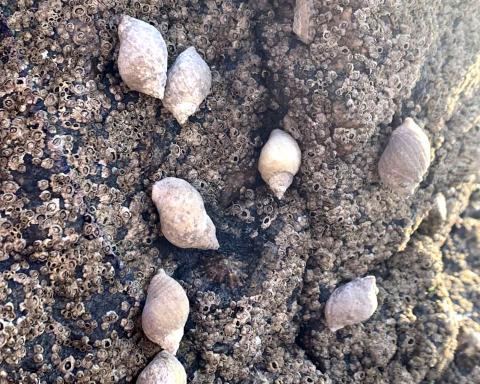Background
Imposex is a condition where female marine snails develop male sexual characteristics, including formation of a vas deferens and growth of a penis. Imposex is caused by exposure to tributyltin (TBT), which was introduced in the 1970s as a biocide in antifouling paint for use on marine vessels. The paint was applied to the hulls of ships and boats but would leach from them into the marine environment. High concentrations of TBT were found in ports and harbours where anti-fouling paint was reapplied to older vessels. Another source of TBT in the marine environment was from treated fish farming netting.
Monitoring for imposex is a very effective and sensitive way to evaluate levels of TBT. The dog whelk (Nucella lapillus) (Figure 1) is a suitable coastline species to target for assessment. Low levels of imposex do not cause significant harm. However, at higher levels females can become sterile which can lead to loss of populations.
The use of TBT-based antifouling paint is now banned from all marine uses, including marine vessels and aquaculture. Since the 1980s, a number of pieces of legislation have been introduced to control this, firstly in yachts and then in larger vessels. A global ban for all ships came into effect in 2008. However, TBT is persistent in the marine environment and is still present in sediment.
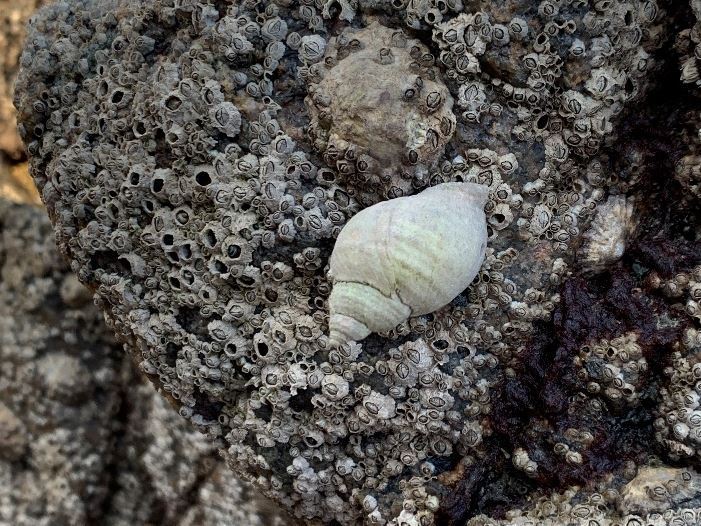
Figure 1: The dog whelk (Nucella lapillus), a suitable coastline species for imposex monitoring
Monitoring tributyltin (TBT) in Scotland’s marine environment is carried out by direct measurement of TBT in sediment and determining the degree of imposex in dog whelk (Nucella lapillus) populations. This work is undertaken as part of the UK Clean Seas Environment Monitoring Programme (CSEMP), an integrated approach to contaminant and biological effects monitoring. CSEMP is operated to ensure a coordinated monitoring programme across the United Kingdom.
The contaminant and biological effects data (including imposex) generated for CSEMP are submitted to the UK Marine Environment Monitoring and Assessment National database (MERMAN), and from there to the International Council for the Exploration of the Seas (ICES) Environmental database. TBT is also monitored in water by the Scottish Environment Protection Agency (SEPA) for the Water Framework Directive (WFD) and included in the Hazardous Substances in the Concentration of contaminants in the water column assessment.
Measuring TBT concentrations directly in sediment is a time consuming, costly and problematic method. In addition, concentrations rarely exceed detection limits. Therefore, only limited monitoring of TBT in sediment from Scottish waters has been undertaken by Marine Scotland Science (MSS) and SEPA.
There are no OSPAR assessment criteria for TBT concentrations in sediment but the Environmental Quality Standard (EQS) proposed by Sweden (Sahlin & Ågerstrand, 2018) is being trialled in OSPAR assessments. This EQS is very close to the achievable detection limits for TBT.
Monitoring of imposex in dog whelks is a very effective and sensitive way to evaluate levels of TBT. It is a mandatory indicator included in the Joint Assessment and Monitoring Programme (JAMP) recommended by OSPAR. MSS leads the imposex monitoring and assessment in Scotland, with assistance from SEPA to collect the dog whelks.
A specific national CSEMP imposex monitoring survey has taken place every 3-4 years since 2000. After 2010, the sampling programme was significantly reduced as imposex had significantly decreased across Scotland (Baxter et al., 2011). Now, only sites that have previously failed are targeted, with the addition of representative sites to increase geographic spread for regional assessment. The imposex data are submitted to MERMAN and these data have been used in the assessment.
The Shetland Oil Terminal Environmental Advisory Group (SOTEAG) commission a dog whelk monitoring programme, including imposex monitoring, in Sullom Voe and Yell Sound funded by the Sullom Voe Association. This programme has been running since 1991 and represents one of the longest time series of biological effects data. These data are also submitted to MERMAN and considered in the assessment. These data dominate the regional data so are included as a case study.
Imposex Assessment
The imposex stage in females (Vas Deferens Sequence (VDS) stages; Table a) is determined following ICES TIMES series protocol no. 24 (Gibbs, 1999). The 2019 assessment of CSEMP data (2000 – 2018) describes the trends and status of imposex at a number of monitoring locations covering four Scottish biogeographic regions – Irish Sea (Clyde and Solway), Minches and Western Scotland, Northern North Sea and Scottish Continental Shelf (Figure 2). See Introduction to see how biogeographic regions relate to Scottish Marine Regions (SMRs) and Offshore Marine Regions (OMRs).
Imposex monitoring data are assessed for status and trends following standard OSPAR approaches (Fryer & Nicolson, 1999; BODC, 2019). OSPAR Background Assessment Criteria (BAC) and Environmental Assessment Criteria (EAC) have been developed for imposex in dog whelks (Table a). OSPAR BACs were developed to test whether observed results are at background or elevated above background and EACs are the threshold above which is considered to be causing environmental harm and of significant concern.
|
Assessment class
|
VDSI
|
Effects and impacts
|
|---|---|---|
|
A (<BAC)
|
VDSI = <0.3
|
The level of imposex in the more sensitive gastropod species is close to zero (0 - ~30% of females have imposex) indicating exposure to TBT concentrations close to zero, which is the objective in the OSPAR strategy of hazardous substances.
|
|
B (>BAC <EAC)
|
VDS I= 0.3 - <2.0
|
The level of imposex in the more sensitive gastropod species (~30 - ~100 % of the females have imposex) indicates exposure to TBT concentrations below the EAC derived for TBT. e.g. adverse effects in the more sensitive taxa of the ecosystem caused by long-term exposure to TBT are predicted to be unlikely to occur.
|
|
C (>EAC)
|
VDSI = 2.0 - <4.0
|
The level of imposex in the more sensitive gastropod species indicates exposure to TBT concentrations higher than the EAC derived for TBT. e.g. there is a risk of adverse effects, such as reduced growth and recruitment, in the more sensitive taxa of the ecosystem caused by long-term exposure to TBT.
|
|
D (>EAC)
|
VDSI = 4.0 - 5.0
|
The reproductive capacity in the populations of the more sensitive gastropod species is affected as a result of the presence of sterile females, but some reproductively capable females remain. e.g. there is evidence of adverse effects, which can be directly associated with the exposure to TBT.
|
|
E (>EAC)
|
VDSI = >5.0
|
Populations of the more sensitive gastropod species unable to reproduce. The majority, if not all females within the population have been sterilized.
|
|
F (>EAC)
|
VDSI = -
|
The populations of the more sensitive gastropod species are absent/expired.
|
Assessments of status and trends were made for a large number of imposex time series, each consisting of VDS measurements in dog whelks at a single monitoring station. The regional assessment synthesises the results of the individual time series to assess status and trends at the biogeographic regional level.
A time series of VDS measurements is assessed for status if there:
- is at least one year with data in the period 2013 to 2018;
- are at least three years of data over the whole time series.
A time series is also assessed for trends if there are at least three years of data with individual measurements or four years of data with pooled measurements.
Further information on how the individual time series are assessed for status and trends can be found on the BODC website.
For the regional assessment, the results from the individual time series are combined. Essentially, a summary measure of status or trend is obtained from each time series. These are then modelled, using a linear mixed model, to estimate the mean status or the mean trend in each biogeographic region. Only biogeographic regions with at least three monitoring stations with good geographic spread are considered in the regional assessment.
The trend analysis is further restricted to time series from monitoring stations that are classified as ‘representative’ or ‘impacted’ (those close to a point source). ‘Baseline’ stations (those with near pristine conditions or only subject to very diffuse inputs) are omitted because any trends there will likely be caused by different processes to those at representative or impacted stations.
Note that the inclusion of impacted stations differs from the approach used for contaminants (where they are excluded). Many imposex monitoring stations were chosen because they were close to harbours (i.e. impacted). However, the ban of TBT (which causes imposex) will have been the major driver of trends in imposex throughout, so it seems plausible that trends in VDS might be similar (on the logistic scale) at both impacted and representative stations. There are no restrictions on the time series used in the status analysis based on the classification of the monitoring station; time series from baseline, representative and impacted stations are all included.
MSS participates in routine QUASIMEME proficiency testing scheme for determination of imposex in marine snails. This quality assurance and the widely adopted use of the ICES TIMES protocol minimise transboundary effects.
TBT in sediment
The TBT data have not been formally assessed due to the limited data set. Monitoring of TBT in sediment is carried out as part of the CSEMP where sediment is collected during the MSS winter cruise programme. Industrialised areas, such as the Clyde and Forth, are targeted.
MSS is UKAS accredited to ISO 17025 for the determination of organotins in sediment and participate in routine QUASIMEME proficiency testing scheme for determination of TBT in sediment. This quality assurance minimise transboundary effects and increases confidence in the data.
There are no OSPAR assessment criteria for TBT concentrations in sediment but the Environmental Quality Standard (EQS) proposed by Sweden (Sahlin & Ågerstrand, 2018) is being trialled in OSPAR assessments. This proposed EQS is 1.6 μg/kg TBT normalised to 5% total organic carbon. This value is very close to the achievable detection limits for TBT.
Results
Imposex was assessed in dog whelks from four biogeographic regions - Irish Sea (Clyde and Solway), Minches and Western Scotland, Northern North Sea and Scottish Continental Shelf (Figure 2). The data were collected between 2000 and 2018, with surveys completed every 3-4 years.
For regional assessment and trend analysis, only biogeographic regions with a minimum of three suitable stations with a reasonable geographic spread were included. There were insufficient data for regional analysis of the Irish Sea (Clyde and Solway), Minches and Western Scotland and Scottish Continental Shelf regions, although individual sites are discussed in the extended section.
The degree of imposex was categorised by Vas Deferens Sequence (VDS) stages and compared to OSPAR Background Assessment Criteria (BAC) and Environmental Assessment Criteria (EAC). The BAC determines if observed VDS is at background or elevated and EAC identifies if it is causing significant harm. An average VDS below the EAC indicates an acceptable health status.
The level of imposex in the Northern North Sea was above background (Figure 3a) however below the EAC (Figure 3b) indicating that TBT in this area is below concentrations which cause environmental harm.
Trends in imposex were assessed in biogeographic regions where there were at least five years of data (Figure 4). There were sufficient data for trend analysis in the Northern North Sea which concluded that there was a significant downward trend in imposex.
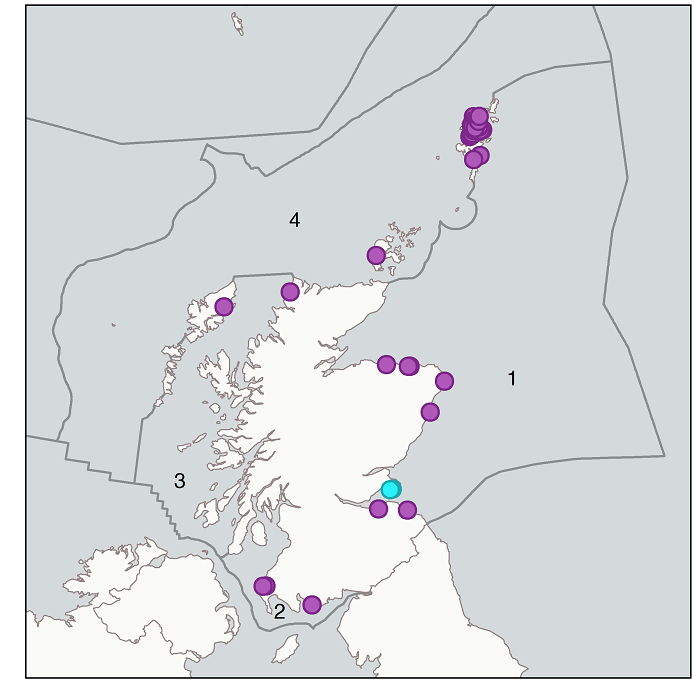
Figure 2: Monitoring stations included in the imposex status and trend assessments in dog whelk populations per biogeographic region (grey lines). Magenta dots = stations for trend and status assessments. Cyan dots = stations for status assessment only. 1, Northern North Sea; 2, Irish Sea (Clyde and Solway); 3, Minches and Western Scotland; 4, Scottish Continental Shelf.
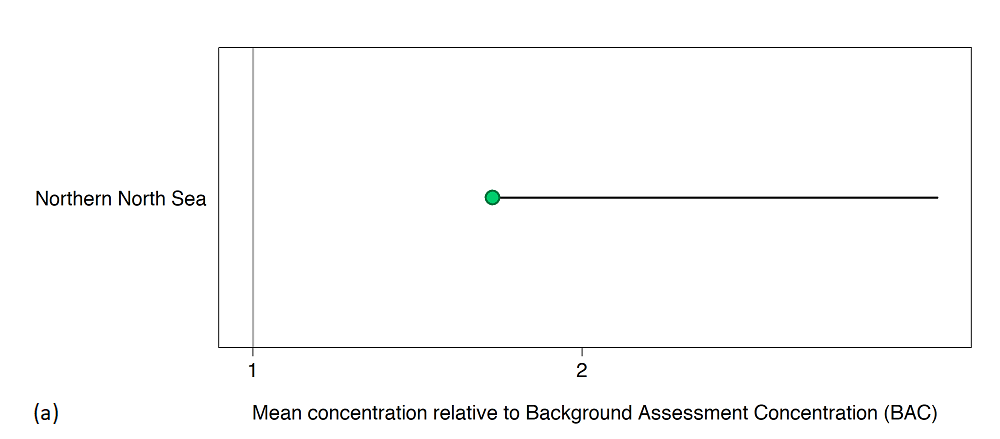
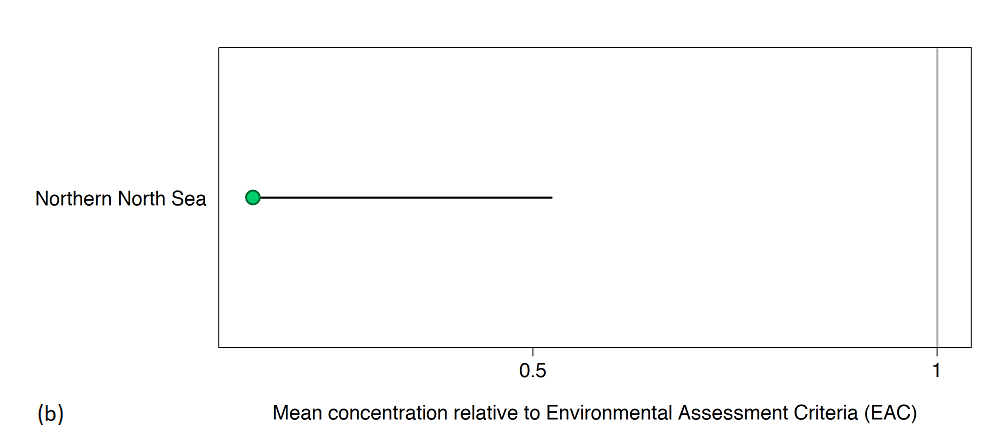
Figure 3: Status assessment; mean Vas Deferens Sequence (VDS, stage of imposex) in each Scottish biogeographic region relative to the OSPAR BAC (a) or EAC (b) (with 95 % confidence limits) where the BAC/EAC value is 1. The VDS is significantly below the BAC/EAC if the upper confidence limit is below 1. Blue = statistically significantly below the BAC. Green = at or above the BAC but statistically significantly below the EAC. Red = at or above the EAC.
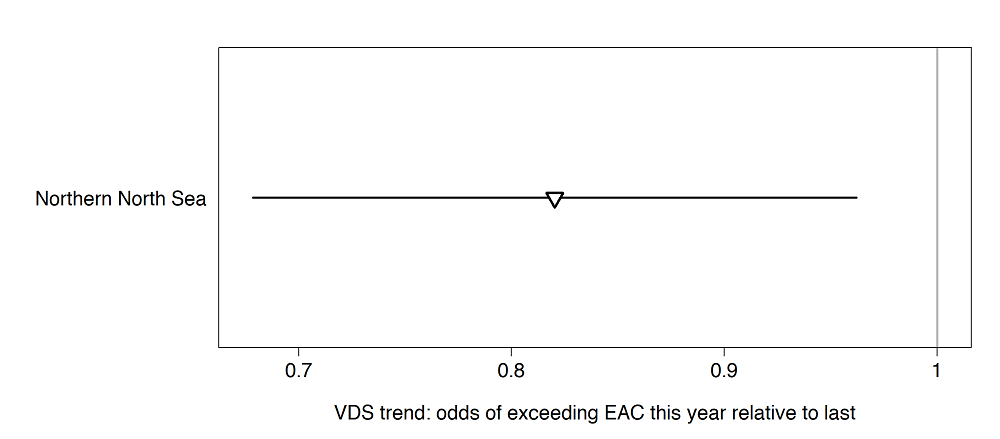
Figure 4: Trend assessment; the estimated trend for the Vas Deferens Sequence (VDS, stage of imposex) exceeding the EAC in one year relative to the previous year sampled in each Scottish biogeographic region. There is a significant trend if the confidence limits does not cut the vertical line at 0. Upward trends (upwards triangle), downward trends (downwards triangle), no change (circle) and 95 % confidence limits (lines).
MSS participates in routine QUASIMEME proficiency testing scheme for determination of imposex in marine snails. Therefore, there is high confidence in the quality of the data used in this assessment. The data have been collected over many years using established sampling methodologies.
In addition, established and internationally recognised protocols for monitoring and assessment are used, therefore there is also high confidence in the methods. The assessment methodology has been developed and improved since the 2011 assessment (Baxter et al., 2011), with a regional assessment being undertaken and presented here rather than the individual station assessment presented in 2011. Also, the 2011 Atlas assessed individual stations based on the imposex class (Table a), as opposed to comparing to OSPAR assessment criteria.
The 2011 Atlas reported that there was a downward trend in imposex in dog whelks across Scotland. Data from 2000-02 and 2007-09 were described and compared. In 2002, several sites were class D but no sites were class E or F. By 2008, the number of class D sites had decreased and the number of class A sites had increased. If the same approach was taken to assess the 2018 survey results, all sites would be class A or B (data not shown).
There were insufficient data to make a regional assessment in the Irish Sea (Clyde and Solway), Minches and Western Scotland and Scottish Continental Shelf regions. This is due to reduction in the number of monitoring sites in these areas following the significant decline in imposex (Baxter et al., 2011). The individual station results from this assessment are shown in Figure a.
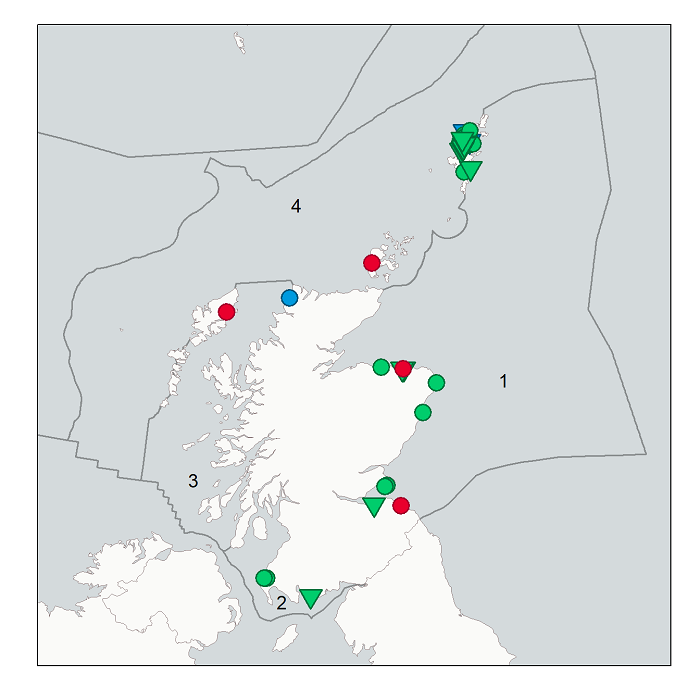
Figure a: Individual trend and status assessments of imposex in dog whelk populations per biogeographic region (grey lines). Blue (•)= statistically significantly below the BAC. Green (•) = at or above the BAC but statistically significantly below the EAC. Red (•)= at or above the EAC. Upward trends (upwards triangle), downward trends (downwards triangle), no change (circle). 1, Northern North Sea; 2, Irish Sea (Clyde and Solway); 3, Minches and Western Scotland; 4, Scottish Continental Shelf.
Irish Sea (Clyde and Solway)
There were three sites in this biogeographic region, two in Loch Ryan and one in Wigtown Bay. All sites were at or above the BAC but statistically significantly below the EAC, indicating that the concentration of TBT in the areas sampled was not causing significant harm. A downward trend was observed from the Wigtown Bay site, whereas the level of imposex in both Loch Ryan sites was considered stable.
Minches and Western Scotland
Only two sites were included in the Minches and Western Scotland. These were both at the North end of the Minch. One site, in Loch Inchard, had a stable level of imposex at background. However, at the other site, in Stornoway Harbour, the level of imposex was above the EAC and stable, indicating that concentrations of TBT in this area are at risk of causing adverse effects.
Northern North Sea
There were sufficient data to make regional assessment of the northern North Sea (Figures 3a, 3b & 4). Most sites were at or above the BAC but statistically significantly below the EAC (Figure a). The two sites that were above the EAC were in the Forth at Barns Ness and at Macduff harbour.
Scottish Continental Shelf
Although there were a number of sites in Shetland, over the entire Scottish Continental Shelf region there was an insufficient geographic spread to carry out a regional assessment. There is only a single site out with Shetland in this region. The level of imposex at this site, in Orkney, was above the EAC. The majority of sites in Shetland are included in a specific survey covering Sullom Voe and Yell Sound. This is included in the Case study: Imposex in Sullom Voe.
TBT in sediment
Concentrations of TBT in sediment were determined at sites within the Forth and Clyde between 2014 and 2017. TBT concentrations were often below the detection limit, but where it was detected it often exceeded the proposed Environmental Quality Standard (EQS).
Scottish Marine Regions
Eleven Scottish Marine Regions (SMRs) were created by The Scottish Marine Regions Order 2015 that cover sea areas extending out to 12 nm. Regional assessments to support Regional Marine Plans are required to be developed for each SMR by the relevant Marine Planning Partnership.
The CSEMP sampling design is based on the biogeographic regions used within UK and MSFD assessments. Therefore there are insufficient data for a regional assessment for all SMRs.
In particular, some SMRs have no, or few (<3), monitoring stations. Forth & Tay is the only SMR that may have sufficient data for a regional assessment. The Shetland SMR may also have sufficient data, however the increased number of sites in Sullom Voe and the Yell Sound may skew the data. Further work is needed to undertake an assessment at the SMR level.
However, each SMR is contained within a biogeographic region or, in some cases, straddles two biogeographic regions (Shetland and Outer Hebrides). Table b shows the SMR and the biogeographic region(s) they are in. Moving forward, additional monitoring stations would be required to enable regional assessments in each SMR. This might be achievable, if suitable species are present. Dog whelks are the preferred species for an assessment as they are intertidal and therefore easiest to collect. Intersex in the common periwinkle (Littorina littorea) is considered too insensitive for application of the assessment criteria and is therefore not a suitable species for assessment.
|
SMR
|
Biogeographic region
|
|
Argyll
|
Minches and Western Scotland
|
|
Clyde
|
Irish Sea (Clyde and Solway)
|
|
Forth and Tay
|
Northern North Sea
|
|
Moray Firth
|
Northern North Sea
|
|
North Coast
|
Scottish Continental Shelf
|
|
North East
|
Northern North Sea
|
|
Outer Hebrides
|
Scottish Continental Shelf
Minches and Western Scotland
|
|
Orkney Islands
|
Scottish Continental Shelf
|
|
Shetland Isles
|
Northern North Sea (east Shetland)
Scottish Continental Shelf (west Shetland)
|
|
Solway
|
Irish Sea (Clyde and Solway)
|
|
West Highlands
|
Minches and Western Scotland
|
Conclusion
Imposex is the biological effect of TBT. This assessment of imposex in dog whelks has only been carried out for the Northern North Sea biogeographic region. The status assessment showed that the level of imposex in this region was elevated above background, however was not at a level that was causing significant harm. The trend assessment concluded that imposex is decreasing in the Northern North Sea. Overall, the assessment indicates that the level of TBT is not causing environmental harm.
There were insufficient data for a regional assessment of status and trends in the other Scottish biogeographic regions. After 2010, the sampling programme was significantly reduced as imposex had significantly decreased across Scotland. Since then sites that had previously failed are the focus of the sampling surveys.
Scotland’s Marine Atlas (2011) reported a general decreasing trend in imposex across Scotland. If the same approach used for the 2011 Atlas was taken to assess the most recent survey results, all sites would be class A or B (data not shown), which is a further decline in imposex.
The assessment methodology has been developed and improved since the 2011 assessment, with a regional assessment being undertaken and presented here, rather than the individual station assessment presented in 2011.
There are still some localised impacted sites where the degree of imposex indicates that these dog whelk populations are being significantly affected by reservoirs of persistent TBT present in the sediment.
The CSEMP sampling design was based around the biogeographic regions used in OSPAR and MSFD assessments, therefore there are insufficient data for status and trend assessments of all SMRs. Each SMR will be within a biogeographic region. However, in most SMRs there will be no or few stations.
Data for TBT in sediment are limited, and concentrations are often below the detection limit, but where TBT is detected in sediments in the Clyde and Forth, concentrations often exceed the proposed EQS.
Knowledge gaps
There are a lack of data available in some biogeographic regions. This is due to a reduction in the survey as the level of imposex was declining. To make a regional assessment to confirm this, further monitoring stations are required in the Irish Sea (Clyde and Solway), Minches and Western Scotland and Scottish Continental Shelf.
There are no OSPAR assessment criteria for TBT concentrations in sediment. The Environmental Quality Standard (EQS) proposed by Sweden is being trialled in OSPAR assessments, however these are not agreed yet.
The imposex assessment methodology does not take into account sites that have been visited, but where there were no animals present, for example, sites that historically have had dog whelk populations that have declined to a level of local extinction due to TBT exposure. Often sites have recovered, but this is not always the case. Unfortunately, if no dog whelks are present at a site it cannot be certain that TBT concentrations remain the reason the site has not been repopulated. Therefore, these sites are excluded from the regional analysis.
Status and trend assessment
This status and trend assessment is an overall assessment for Contaminants in sediment and biota (PAHs, PCBs, PBDEs and metals in sediment and biota) and Biological effects of contaminants.
|
Region assessed
|
Status with confidence
|
Trend with confidence
|
Comments
|
|---|---|---|---|
|
Northern North Sea
|
 |
|
Two stars for confidence in the status is due to lack of suitable assessment criteria for some determinands (metals in biota and some biological effects measurements)
|
This Legend block contains the key for the status and trend assessment, the confidence assessment and the assessment regions (SMRs and OMRs or other regions used). More information on the various regions used in SMA2020 is available on the Assessment processes and methods page.
Status and trend assessment
|
Status assessment
(for Clean and safe, Healthy and biologically diverse assessments)
|
Trend assessment
(for Clean and safe, Healthy and biologically diverse and Productive assessments)
|
||
|---|---|---|---|
 |
Many concerns |
No / little change |
|
 |
Some concerns |
Increasing |
|
 |
Few or no concerns |
Decreasing |
|
 |
Few or no concerns, but some local concerns |
No trend discernible |
|
 |
Few or no concerns, but many local concerns |
All trends | |
 |
Some concerns, but many local concerns |
||
 |
Lack of evidence / robust assessment criteria |
||
| Lack of regional evidence / robust assessment criteria, but no or few concerns for some local areas | |||
 |
Lack of regional evidence / robust assessment criteria, but some concerns for some local areas | ||
| Lack of regional evidence / robust assessment criteria, but many concerns for some local areas | |||
Confidence assessment
|
Symbol |
Confidence rating |
|---|---|
|
Low |
|
|
Medium |
|
|
High |

Assessment regions

Key: S1, Forth and Tay; S2, North East; S3, Moray Firth; S4 Orkney Islands, S5, Shetland Isles; S6, North Coast; S7, West Highlands; S8, Outer Hebrides; S9, Argyll; S10, Clyde; S11, Solway; O1, Long Forties, O2, Fladen and Moray Firth Offshore; O3, East Shetland Shelf; O4, North and West Shetland Shelf; O5, Faroe-Shetland Channel; O6, North Scotland Shelf; O7, Hebrides Shelf; O8, Bailey; O9, Rockall; O10, Hatton.




